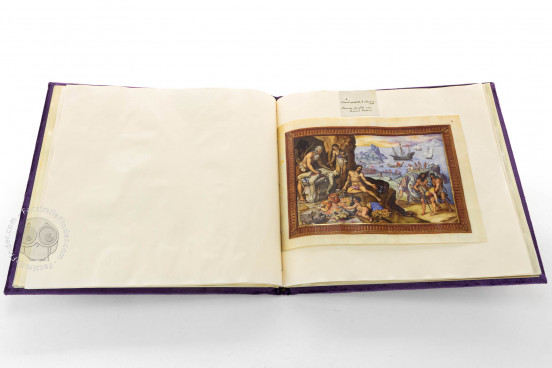The Triumphs of Charles V is a bound album of painted miniatures on parchment commemorating the military victories of Charles V, Holy Roman Emperor from 1519 to 1556. The paintings were commissioned by Philip II of Spain as copies from engravings by Dirck Volkertszoon Coornhert of drawings by Maerten van Heemskerck and published by Hieronymus Cock in 1556. Although they were once attributed to Giulio Clovio, the commission occurred in the 1590s and therefore have been recently attributed to Simonzio Lupi.
The album is a treasure of Italian Renaissance painting and design in both its grand subject matter and its dramatic realism. It remained in the Escorial library in Spain until it was removed during a period of war in the early nineteenth century and eventually sold to Thomas Grenville, who bequeathed the newly-bound collected to the British Museum in 1847. That these images were first drawn in the Netherlands, copied in Italy for the Spanish crown, sold in Paris, and taken to London feature the emperor who once ruled most of Europe make this work a truly exceptional witness to and record of a pivotal historical period.
Painted Copies of Netherlandish Engravings
With the advent of printing in the late fifteenth century, artists began to see their drawings and paintings engraved the prints sold as souvenirs and commemorative pieces. This allowed for the wide dissemination of singular works which produced a Europe-wide marketplace for artists and for a more uniform style of art to develop.
These paintings were commissioned specifically as color works duplicating engravings produced from drawings of Maerten van Heemskerck, who as an artist had Italian training and produced several series of popular images to be sold as prints as well as individual paintings. He is credited with the introduction of Italian techniques and styles into the Low Countries.
The paintings themselves, however, were produced in Italy for the Spanish crown making the Triumphs of Charles V a truly international project.
Humanistic Quatrains in Renaissance Cartouches
As companion pieces to the artwork, twelve descriptive quatrains in Spanish are framed by elaborate, brightly colored cartouches. These feature typical Italian Renaissance motifs such as scallop shells, putti, green men, and curling bands of thick scrollwork all shaded to achieve a three-dimensional trompe l’oeil effect.
The quatrains adhere to an ABAB rhyming scheme over four long lines in a square Humanistic script. Additional inscriptions “Giulio Clovo. L’Aguila Triumphante de Carlos Quinto” and “Finis” in gold Roman Uncial were added in the nineteenth century when the folios were bound together in the present album.
Charles V and the Creation of Europe
Charles V was Holy Roman Emperor in the first half of the sixteenth century. His reign consolidated most of Europe under his domain with the exception of France and England. His reign also coincided with the European colonization of the Americas and his sponsorship of expeditions played a major role in the shaping of the modern age.
Charles’s military victories were instrumental in the establishment of the first truly global empire “upon which the sun never set” and commemorative prints and paintings such as those in this album demonstrate the importance he held both to his contemporaries and in the development of world history over the next centuries.
Binding description
The twelve sixteenth-century parchment leaves were bound together in a larger album with paper interleaves in the early nineteenth century, either just before or after their purchase by Thomas Grenville around 1817. They were bound by Charles Lewis in purple velvet within a dark blue Morocco case. The case is velvet lined with a bespoke recess for a contemporary magnifying glass and is locked by means of a key, both retained with the case.
We have 1 facsimile edition of the manuscript "Triumphs of Charles V": Triunfos de Carlos V (Gold series) facsimile edition, published by Patrimonio Ediciones, 2014
Request Info / Price





















